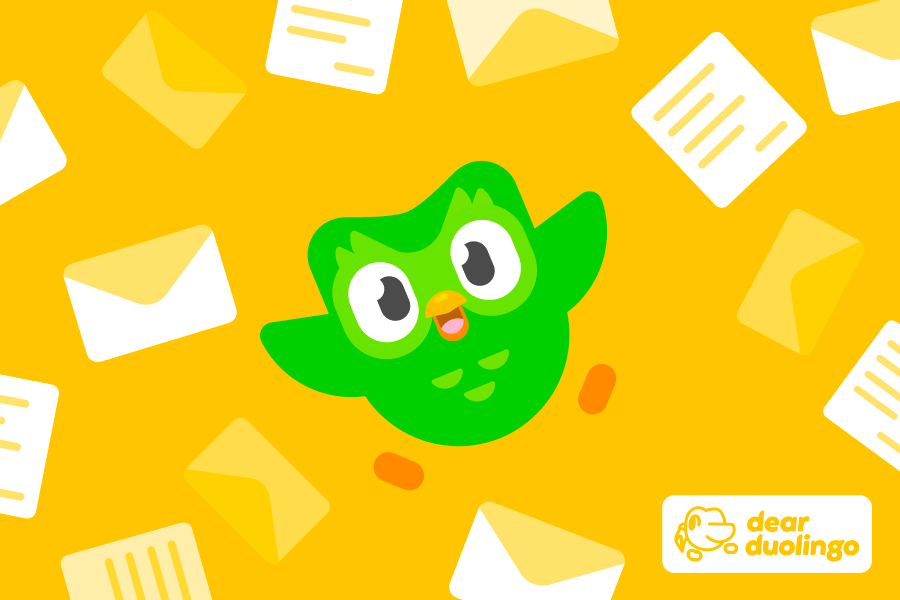Welcome to another week of Dear Duolingo, an advice column just for learners. Catch up on past installments here.
Hello there, dear learners! Dr. Hope Wilson here. I'm excited to answer this week's Dear Duolingo question because it touches on something near and dear to my heart (which also happens to be my job): figuring out the best way to teach languages! Specifically, figuring out the best order for teaching language topics—something a little bit harder than A, B, C, and more complicated than 1, 2, 3…
Our question this week:

I had the exact same experience in middle school Spanish! Just like you, we started with those basic childhood building blocks, chanting ah be ce de eh efe ge and differentiating things that were rojo from things that were azul.
So it was quite a surprise when, in college, my first Russian class jumped right into having us talk about what our major was. We didn’t even learn our first number until we started learning how to go shopping, which was a few months in! And even though we learned to write in Cyrillic, we didn’t actually learn the names of the letters.
Why were these two classes structured so differently? Because they adopted two very different teaching philosophies. My college class—like Duolingo—was based in the *communicative approach* to language teaching.
Why Duolingo adopts a communicative approach
When we’re building a Duolingo course, we make a few assumptions about our learners:
- We assume that most of our learners are adults. This isn’t 100% true, of course—but we assume our learners can already read and write in their language and that they have lives and interests typical of adults.
- We assume that most of our learners want to use the language. Note that this isn’t universally true, either. Some people want to learn a language just for fun! But most of our learners want to learn languages so they can communicate.
So if a learner is using a language to live their lives, they need to be able to accomplish certain things with that language. For example, they need to be able to hold a conversation about themselves and their lives so they can connect to other people. They also need to be able to go to a store and buy their own food, instead of acting like a baby and wordlessly screaming until food is brought to them. (Babies have it so easy.)
A communicative language course is designed to teach learners what they need to live their lives—and to do so from the very start. Things like the alphabet and colors and even details about grammar take a backseat.
We do this by systematically identifying and defining communicative objectives that vary according to language level.
So the Duolingo courses that are CEFR-aligned—designed to meet international language standards— generally start from the first unit with phrases like Coffee, please! (We understand what matters in life.) And we try to cover topics like the following within the first 15 units of a course:
- How do you order food?
- How do you get help during a minor emergency? Like, what if you’re lost or your phone runs out of battery—what do you do?
- How do you navigate passport control and customs after you arrive in a new country?
- How do you navigate a store to find crucial supplies, like chargers and socks?
By ensuring that we cover this stuff first, we equip learners with what we sometimes refer to as “survival language”—the stuff you need to meet the lowest level on Maslow’s hierarchy of needs. Once you've learned that, only then do we start to branch out into things that are less immediately necessary.
Is there a place for the ABCs?
So does a Duolingo course even teach those traditional “building blocks”?
Well, in keeping with our communication-focused approach, we teach these concepts when they’re needed. For example, we tend to teach numbers when they're essential to the topic—like paying a bill or telling the time. Colors are taught when learning about clothing and differentiating items from one another.
As for the alphabet, it becomes relevant at different times for different languages. Let’s say I was constructing a Spanish course. I might consider the following:
- My beginning learners do need to know how to pronounce words, so they can effectively read Spanish.
- My beginning learners don’t really need to know letter names, because they can always ask someone to write something down. (And writing Spanish is a skill that's useful for more than just spelling your name or an address!)
- And they don’t really need to know specific spelling rules yet, because they can always use spell check to help them. (Beginners aren't writing professional emails or college essays.)
Now, if I was designing advanced Spanish lessons, this might be different. Maybe I’d want my advanced learners to have absolute precision in their spelling—and in that case, maybe I’d want to teach them the specifics of the alphabet. (So, ironically enough, this “basic building block” is actually primarily useful for advanced learners!)
I might also time things differently for an English course. (English spelling and pronunciation are tricky, and learners often need extra support — that’s why our English courses now have extra pronunciation features.) And, of course, if I were teaching Japanese to an English-speaking learner, we’d have to spend some time learning to read and write three writing systems! (And luckily, Duolingo has a tool for that.) So there can be variation in what gets taught first.
Basically… the "basics" aren't so basic!
We build Duolingo courses to get to what matters most as quickly as possible, so that our learners can fill their most basic needs right away. And learning the ABCs isn’t nearly as important as being able to communicate ASAP!
For more answers to your language and learning questions, get in touch with us by emailing dearduolingo@duolingo.com.
